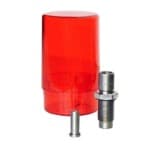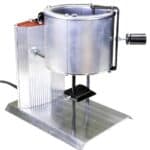
Introduction to Cast Bullet Lubrication
Lubricating cast bullets is an essential process that enhances their performance, accuracy, and longevity. Without proper lubrication, lead fouling and excessive barrel wear can occur, leading to poor shooting results and increased maintenance. Whether you are a seasoned bullet caster or just starting, understanding the importance of bullet lubrication and the different methods available can significantly impact your shooting experience.
In this guide, we will explore:
- The primary reasons for lubricating cast bullets
- The different lubrication methods, including traditional and modern techniques
- How bullet hardness and sizing affect lubrication
- The role of gas checks in reducing lead fouling
- A historical perspective on bullet lubrication
- The best practices for optimizing your cast bullet performance
By the end of this article, you'll have a complete understanding of bullet lubrication and how to choose the best method of lubricating for your specific shooting needs.
Why Lubricate Cast Bullets?
1. Friction Reduction
The primary reason for lubricating a bullet is to reduce friction between the bullet and the barrel’s rifling. A lubricated bullet glides more smoothly through the bore, minimizing barrel wear and preserving accuracy over prolonged shooting sessions.
2. Lead Fouling Prevention
Unlubricated or improperly lubricated lead bullets can result in excessive lead fouling, where molten lead is deposited onto the rifling. Over time, this buildup affects accuracy and requires extensive cleaning to remove. Proper lubrication creates a barrier, reducing lead adherence to the barrel.
3. Pressure and Velocity Optimization
Lubrication plays a crucial role in ensuring consistent chamber pressures and optimal velocities. A well-lubricated bullet maintains uniform contact with the rifling, leading to improved shot-to-shot consistency and better ballistic performance.
4. Heat and Barrel Longevity
While lubricating the bullet does not significantly reduce overall heat from the burning powder, it does help minimize localized friction-induced heat. This can extend barrel life by preventing excessive erosion and damage over time.
5. Improved Accuracy
Well-lubricated bullets promote uniformity in velocity and chamber pressure, leading to improved accuracy and better overall performance in both handguns and rifles.
Traditional and Modern Bullet Lubrication Methods
1. Lubricator/Sizer Machine Method
One of the most efficient and precise methods of lubricating cast bullets is using a lubricator/sizer machine. This device:
- Sizes and lubricates bullets in a single step
- Uses a die to force lube into the bullet’s lube groove
- Ensures uniform coverage, leading to consistent ballistic performance
Best for:
- High-volume reloaders
- Bullets fired at moderate to high velocities (1,000–1,800 fps)
- Precision shooting where consistency is crucial
2. Pan Lubrication Method
For those who don’t have a lubricator/sizer, pan lubrication is a simple and cost-effective method of lubricating bullets. This involves:
- Standing cast bullets upright in a shallow pan
- Pouring melted bullet lube until it covers the lube grooves
- Letting the lube harden before removing the bullets
Best for:
- Shooters who prefer a budget-friendly method
- Bullets fired at lower velocities (1,000–1,500 fps)
3. Tumble Lubrication Method
Tumble lubing is one of the quickest ways of lubricating bullets, using a liquid lube such as Lee Liquid Alox. The process involves:
- Placing bullets in a container with a small amount of liquid lube
- Gently shaking the container to coat the bullets evenly
- Allowing them to dry before loading
Best for:
- Low to moderate velocity loads (600–1,200 fps)
- Shooters who prefer a fast and easy lubrication method
4. Powder Coating Method (Modern Alternative)
While not a traditional lubrication method, powder coating has become increasingly popular among reloaders. Powder-coated bullets are:
- Coated with a polymer powder and baked to form a durable, smooth layer
- Fully encapsulated, preventing lead fouling and barrel contamination
- Capable of achieving higher velocities (up to 2,000 fps or more) without excessive leading
Best for:
- High-velocity applications (including rifles)
- Shooters who want a cleaner and more durable alternative to traditional lubes
- Reducing smoke and barrel fouling
How Bullet Hardness and Sizing Affect Lubrication
1. Importance of Proper Bullet Sizing
A cast bullet should be 0.001” to 0.002” larger than bore diameter for the best performance. Undersized bullets allow gas blow-by, which leads to excessive leading regardless of lubrication.
2. Bullet Hardness and Lubrication Needs
- Soft Alloys (BHN 8-10): Require more effective lubrication due to increased deformation under pressure.
- Medium Hardness (BHN 12-15): Common for general-purpose handgun bullets.
- Hard Cast Bullets (BHN 18+): Better suited for high-pressure loads and may work well with minimal lubrication or powder coating.
Gas Checks: An Additional Lead-Fouling Solution
Gas checks are small metal cups crimped onto the base of cast bullets to prevent leading and improve performance. They are especially useful in:
- High-velocity applications exceeding 1,500 fps
- Reducing pressure spikes
- Enhancing accuracy by ensuring uniform bullet base integrity
Historical Evolution of Lubricating Bullets
The history of lubricating bullets dates back to black powder days, when shooters used greased patches and tallow-coated lead balls. As smokeless powder replaced black powder, traditional greases evolved into beeswax-based lubes. Modern innovations, such as Alox-based lubes and powder coating, have transformed cast bullet lubrication into a highly efficient and precise process.
Choosing the Best Bullet Lubrication Method for Your Needs
| Method | Cost | Equipment Needed | Best for Velocities | Ease of Application | Messiness |
|---|---|---|---|---|---|
| Lubricator/Sizer | High | Requires a sizer | 1,000–1,800 fps | Precise & efficient | Low |
| Pan Lubing | Low | No special tools | 1,000–1,500 fps | Time-consuming | Medium |
| Tumble Lubing | Very Low | No special tools | 600–1,200 fps | Quick & inconsistent | High |
| Powder Coating | Medium | Oven, powder, container | Up to 2,000 fps+ | Labor-intensive, effective | Low |
Conclusion
Proper bullet lubrication reduces lead fouling, improves accuracy, and enhances barrel life. Whether using a traditional wax-based lube or modern powder coating, the right lubrication method depends on your shooting style, bullet alloy, and velocity needs. By following best practices and understanding how bullet lubrication works, you can optimize your cast bullet performance and achieve superior results on the range and in the field.
If you know of any forums or sites that should be referenced on this listing, please let us know here.



